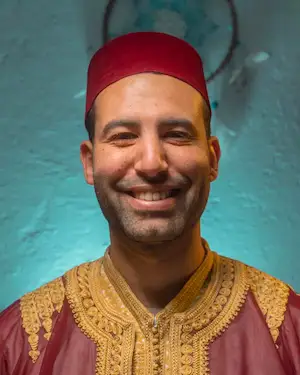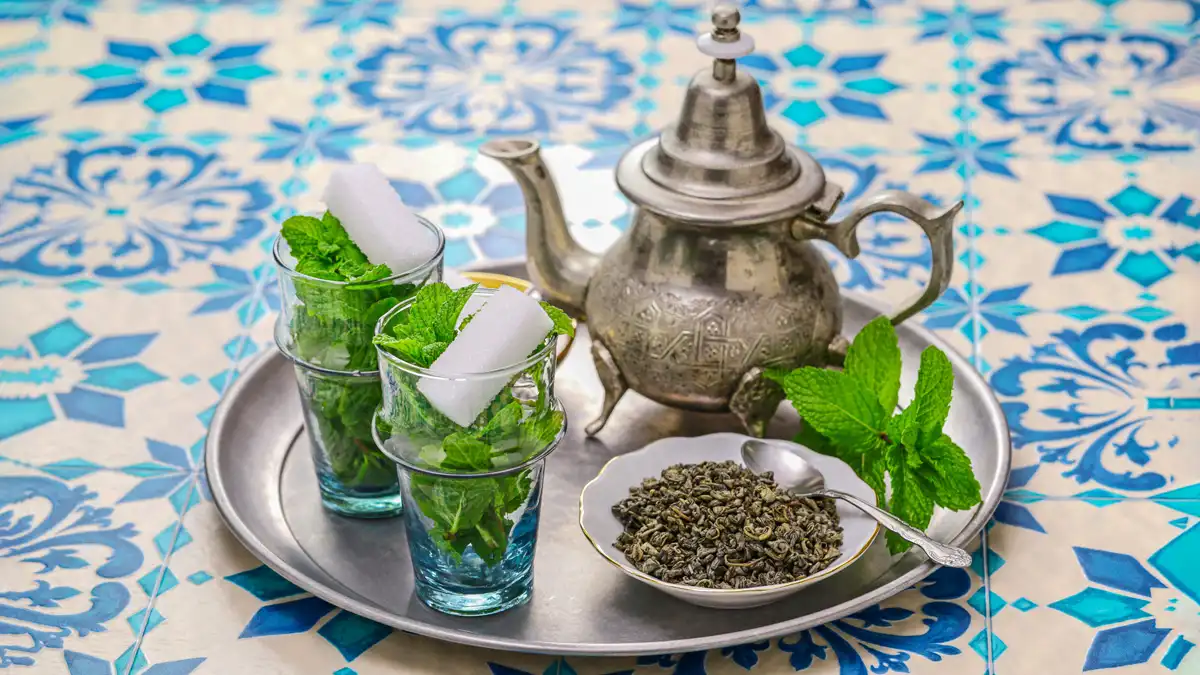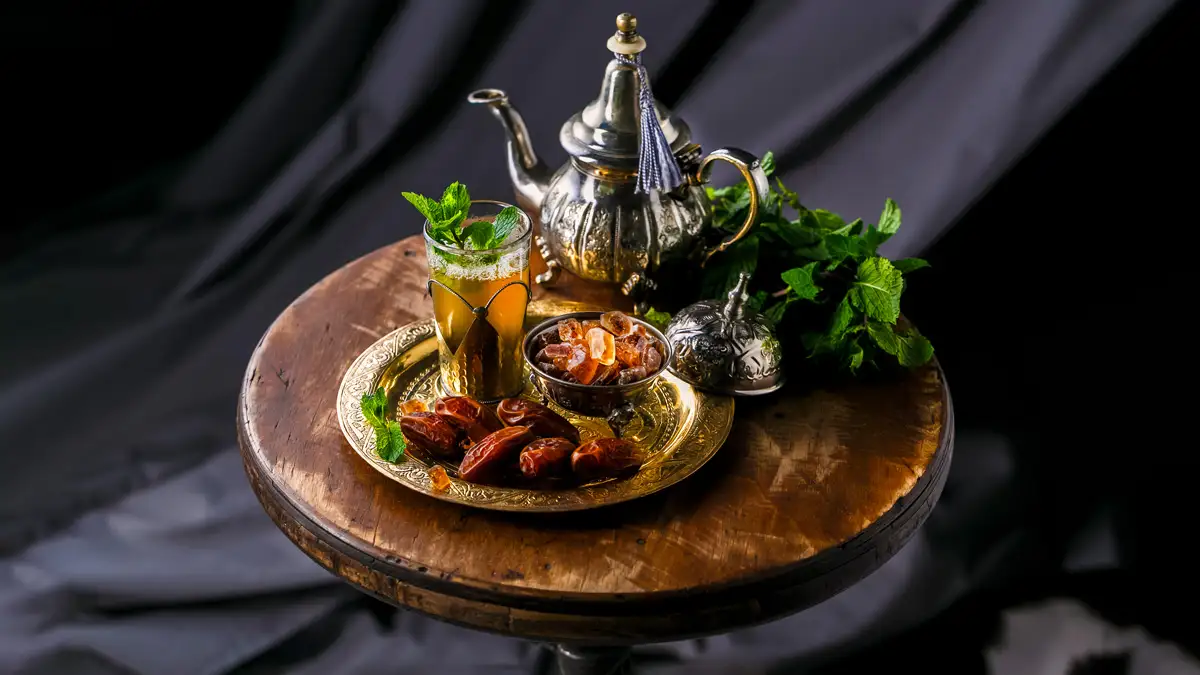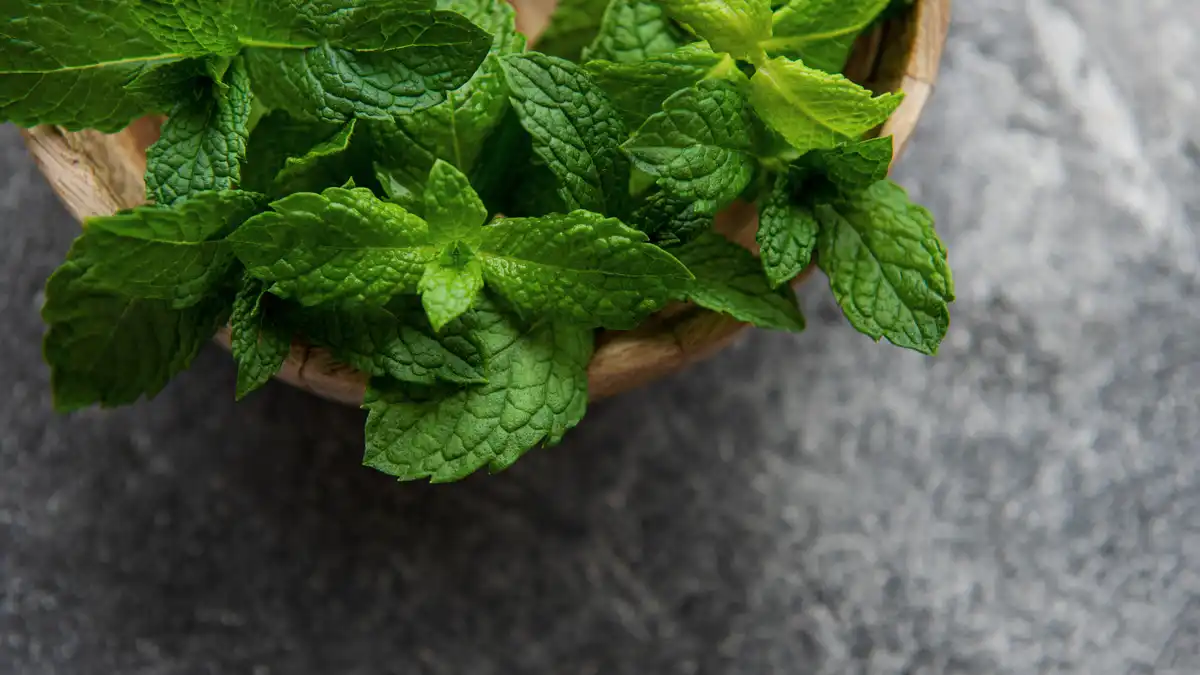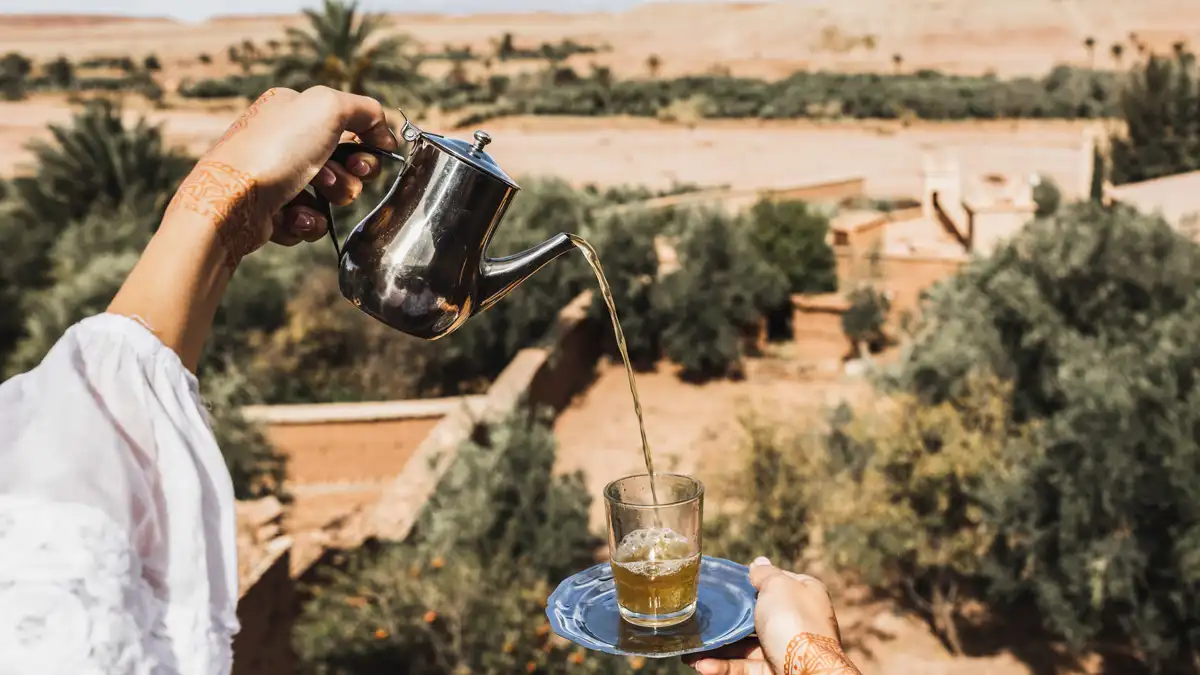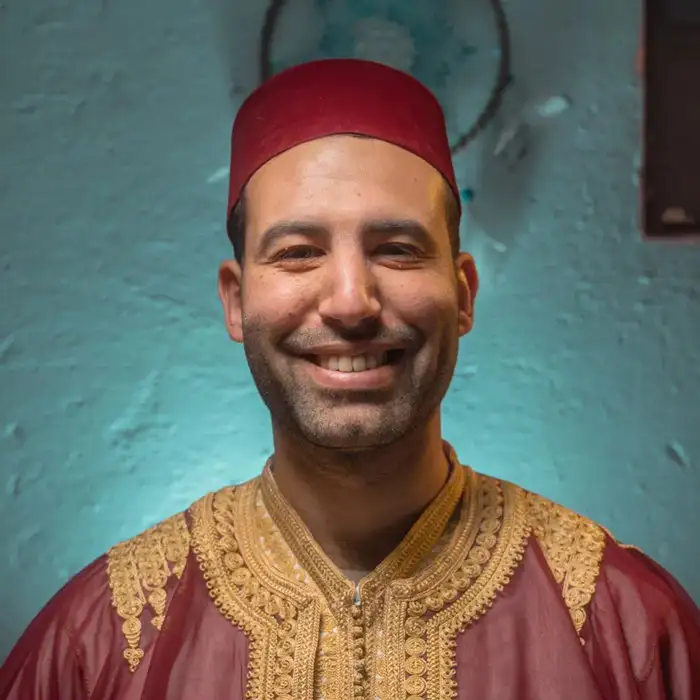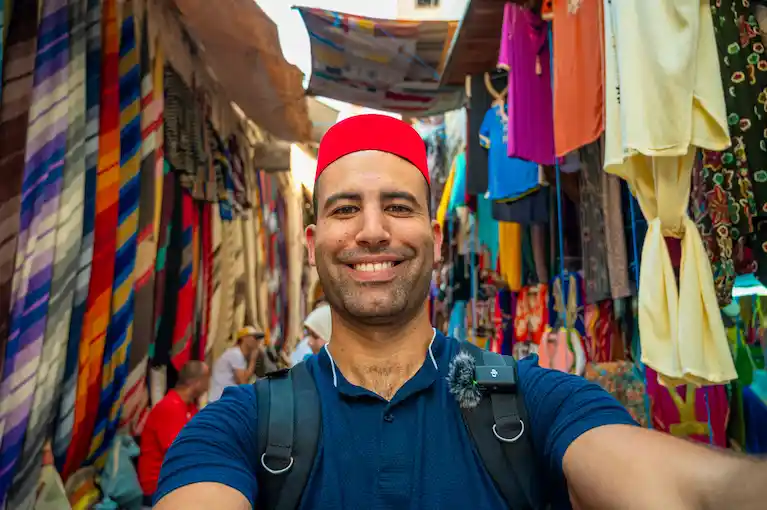Moroccan Mint Tea Or Moroccan Whiskey
Moroccan Mint Tea, or “Atay b’Naanaa”, is more than just a drink. It symbolizes hospitality, culture, and tradition, that’s deeply embedded in the Moroccan daily life. It is served everywhere in Morocco; in homes, cafes, desert camps, and marketplaces. In this article, I’ll share everything you need to know about Moroccan Mint Tea—what it is, its history, how to make it, when and where it’s commonly consumed, and the best places to enjoy an authentic cup while traveling in Morocco.
What Is Moroccan Mint Tea?
Moroccan Mint Tea combines green tea, fresh mint leaves, and sugar to create a refreshing, sweet, and aromatic drink. While simple in its ingredients, the preparation and presentation of mint tea in Morocco are unique and significant.
The tea is traditionally made using Chinese green tea (typically Gunpowder tea), which has a strong, earthy flavor. Fresh mint leaves are added during brewing to give the tea its signature minty aroma. Sugar is often added generously, which results in a sweet and refreshing drink that’s hard to resist.
In Morocco, mint tea is more than a beverage—it’s a way to welcome guests, celebrate gatherings, and share a moment of connection with others.
The History of Moroccan Mint Tea
Moroccan Mint Tea has its roots in trade and cultural exchange. It is believed that green tea was first introduced to Morocco in the 18th century by British merchants who traded tea for goods like leather and spices. Over time, Moroccans adapted the tea to their own taste, adding fresh mint and sugar, which were readily available in the region.
Mint, especially spearmint (known locally as “naanaa”), has been used in Moroccan cuisine and herbal remedies for centuries. Adding mint to tea gave it a distinct flavor and made it an instant favorite nationwide. By the 19th century, Moroccan Mint Tea had become a staple, often called “Moroccan whiskey” because of its widespread consumption and social importance.
Today, it’s considered Morocco’s national drink and is served during family meals, business meetings, and traditional ceremonies.
Moroccan Mint Tea Recipe
If you want to make authentic Moroccan Mint Tea at home, it’s pretty simple. However, the key to getting the right flavor lies in the process of brewing and pouring. Here’s how to do it:
Ingredients:
- 2 tablespoons of Chinese Gunpowder green tea
- 5-6 cups of boiling water
- 1 large handful of fresh spearmint leaves (naanaa)
- 1/2 cup of sugar (adjust to taste)
- A traditional Moroccan teapot (or any teapot will work)
Instructions:
- Rinse the Tea: Add green tea leaves to the teapot. Pour about half a cup of boiling water over the leaves, swish it around, and then pour out the water. This step helps to rinse off any bitterness and clean the tea leaves.
- Steep the Tea: Add 5-6 cups of boiling water to the teapot with the rinsed tea leaves. Let it steep for 3-5 minutes.
- Add Mint and Sugar: Add the fresh mint leaves and sugar directly to the teapot after steeping. Stir gently to dissolve the sugar.
- The Traditional Pouring Method: To achieve the perfect Moroccan Mint Tea, how you pour it matters. Moroccans often pour the tea from a height into small, decorative glasses. This creates a light foam on the surface, which is a sign of a well-made tea.
- Taste and Adjust: Taste the tea and adjust the sugar or mint if needed. Serve hot and enjoy!
When and Where Is Mint Tea Consumed in Morocco?
Moroccan Mint Tea is consumed at any time of the day and in almost every setting. It’s served with breakfast, lunch, and dinner and is also enjoyed during tea breaks or as a midday refreshment.
The tea is prevalent during family gatherings, where it’s served to welcome guests. If you’re invited to someone’s home in Morocco, you can expect to be greeted with a tray of mint tea and perhaps a plate of Moroccan pastries like msemen (flatbread) or chebakia (honey-coated cookies).
Mint tea is also a central part of traditional Moroccan ceremonies, including weddings and religious celebrations. In rural areas, farmers often take a break during their workday to enjoy a cup of tea under the shade of olive or argan trees.
Ramadan is another time when mint tea plays an important role, as it’s commonly served to break the fast during iftar alongside dates and soup.
Regions Where Moroccan Mint Tea Is Most Popular
While mint tea is enjoyed throughout Morocco, certain regions are mainly known for their tea culture:
Chefchaouen: In this northern mountain town, you’ll find small cafes serving mint tea with stunning views of the blue-painted streets and surrounding mountains.
Fez: Known for its traditional culture, Fez offers countless teahouses where you can sip mint tea and watch the hustle of the old medina.
Marrakech: The Jemaa el-Fnaa square in Marrakech is a popular place to enjoy tea while soaking in the sights and sounds of street performers and food vendors.
Rural Villages: For an authentic experience, visit a rural village in the Atlas Mountains, where locals often prepare tea over a charcoal fire and serve it with freshly baked bread.
What to Eat with Mint Tea
In Morocco, mint tea is often served with traditional snacks and sweets. Some common pairings include:
- Msemen: A flaky Moroccan flatbread, often eaten with honey or cheese.
- Chebakia: Sweet, sesame-coated pastries commonly served during Ramadan.
- Dates and Almonds: A classic combination, perfect for afternoon tea.
- Kaab el Ghazal: Almond-filled pastries shaped like crescent moons.
These foods complement the sweet, refreshing taste of mint tea and are often served together during celebrations or casual gatherings.
The Symbolism of Moroccan Mint Tea
Mint tea is more than just a beverage; it’s a symbol of Moroccan hospitality and generosity. Serving tea to guests is a sign of warmth and respect, and it’s customary to offer at least three servings to show good hospitality.
In rural areas, you may witness the traditional tea ceremony, where the host carefully prepares and pours the tea while engaging in friendly conversation. The ceremony is an art form in itself, emphasizing patience and attention to detail.
Where to Enjoy Authentic Mint Tea in Morocco
If you’re visiting Morocco and want to experience authentic mint tea, here are some recommended spots:
Cafes in Chefchaouen: Sit in a small cafe overlooking the blue streets and sip freshly brewed tea.
Traditional Riads in Fez: Many riads serve complimentary mint tea to guests upon arrival, offering a warm welcome.
Street Vendors in Marrakech: The bustling Jemaa el-Fnaa square is the perfect place to enjoy a glass of tea while watching the action around you.
Berber Camps in the Sahara Desert: After a day of camel trekking, relax with a warm cup of mint tea under the stars.
Moroccan Mint Tea is an experience that shows the country’s hospitality, culture, and love for simple pleasures. Whether you’re sipping it in the blue streets of Chefchaouen or in a traditional riad in Fez, mint tea is a must-try for any traveler.
If you plan to visit Chefchaouen or other Moroccan destinations, consider joining one of our private tours from Fez or Casablanca to Chefchaouen. These tours allow you to explore Morocco’s culture and enjoy plenty of authentic mint tea along the way.

